Best Practices for Optimizing Your Shopify Store Pages

You already know that landing pages are great for converting visitors to buyers. That’s why you started using them to customize your Shopify store!
But merely creating a store landing page isn’t enough if you want to maximize revenue. You also need to ensure each page is optimized.
That in mind, today we’ll cover:
- The median and average ecommerce landing page conversion rates (so you’ve got a benchmark to aim for as you optimize), and
- Some of the best practices for conversion rate optimization you should follow for your store.
#cta-paragraph-pb#Wait, what’s a conversion rate? Conversion rate measures the percentage of the people that visit a web page and complete a specific goal. For example: If 500 people visit your product page and 16 people buy the product, the conversion rate of this sales page is 3.2%.
What is the average ecommerce landing page conversion rate?
After analyzing 33 million conversions, it’s been discovered that the median ecommerce landing page conversion rate is 5.2% in 2021.
This is an increase from 2020 when the median was 4.0%.
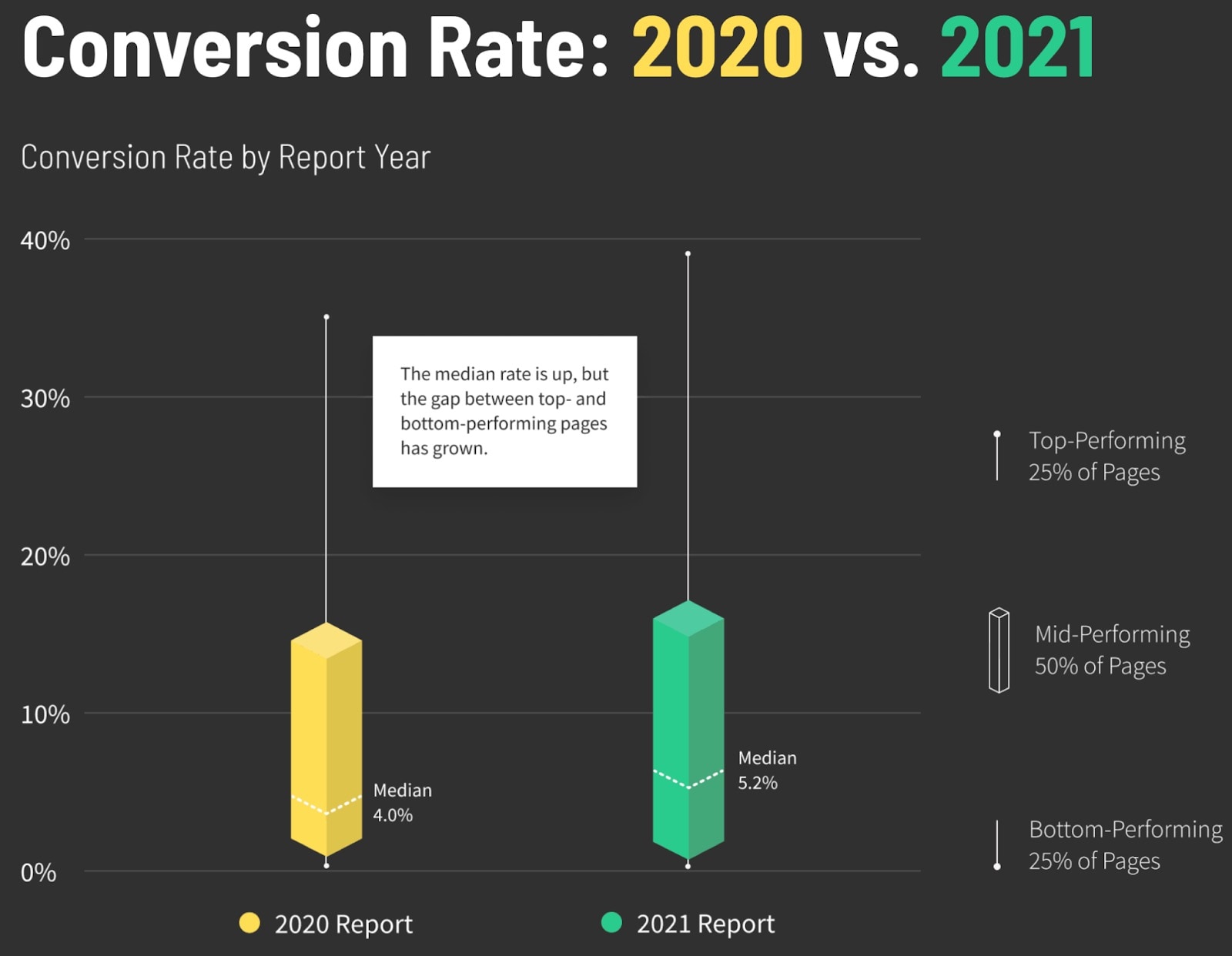
Using these figures, we can benchmark that ecommerce conversion rates typically range from approximately 1.81% – 5.2%. The median is less impacted by outliers (pages converting very well or very poorly), so it might be good to set a goal for your Shopify store’s pages to convert at 5% or above.
That said, some ecommerce landing pages achieve conversion rates of almost 40%! Of course, these are extreme outliers, but can indicate you can aim big with the right offer!
To increase the conversion rates of your Shopify pages, you need to customize them.
How will customizing your Shopify landing pages increase conversions?
Conversion rate optimization is a structured approach to increase conversions through understanding your visitor’s behavior with the help of analytics and feedback.
By understanding how visitors are interacting with your store’s offers, you can then customize specific pages to increase the number of passive browsers that become buyers.
First, you’ll need to build your own testing and optimization plan. The plan should focus on identifying how your current pages perform and what small tweaks you will use to improve them, like design elements, site speed improvements, and sales copy.
This often involves A/B testing—the comparison between two versions or “variants” of a landing page.
Let’s go through the types of things you’ll want to try as you optimize your pages via testing.
Actionable tips for optimizing different types of pages on your ecommerce store
Here’s a list of things you may want to try that will help you with Shopify store optimization and build Shopify pages that have especially high conversion rates:
#1) Understand your audience & target specific segments with custom pages
92% of consumers will visit a brand’s website for the first time for reasons other than making a purchase. Taking the time to understand these visitors is essential, as you’ll gain the insights needed to persuade them to stick around.
So before you start writing landing page copy or decide which images to use, learn as much as you possibly can about your ideal store customers.
You want to know:
- What do they want to achieve?
- What are they struggling with?
- What are they afraid of?
- What are they ashamed of?
- What are they proud of?
- How do they see themselves?
- How do they want to be seen by others?
Your aim should be to get to the point where you understand your potential shoppers better than they know themselves!
Then you’ll be able to build dedicated landing pages in your Shopify store (where appropriate for various offers) for each customer segment. A page that truly resonates with a given shopper.
#2) Test out images that catch your customer’s eye
The brain processes entire images as quickly as 13 milliseconds—much faster than text. Displaying rich images on your store can direct visitors’ eyes to your products and help them feel like the product is already delivered.
It’s important to use high-quality and emotion-invoking images to drive visitors toward taking action. The images should present your products well, in a good light, and from different angles.
Shogun customer Active Doodie Dad Gear use bright and clear images on their Shopify collection page. The white background also accentuates the bold colors of the products.
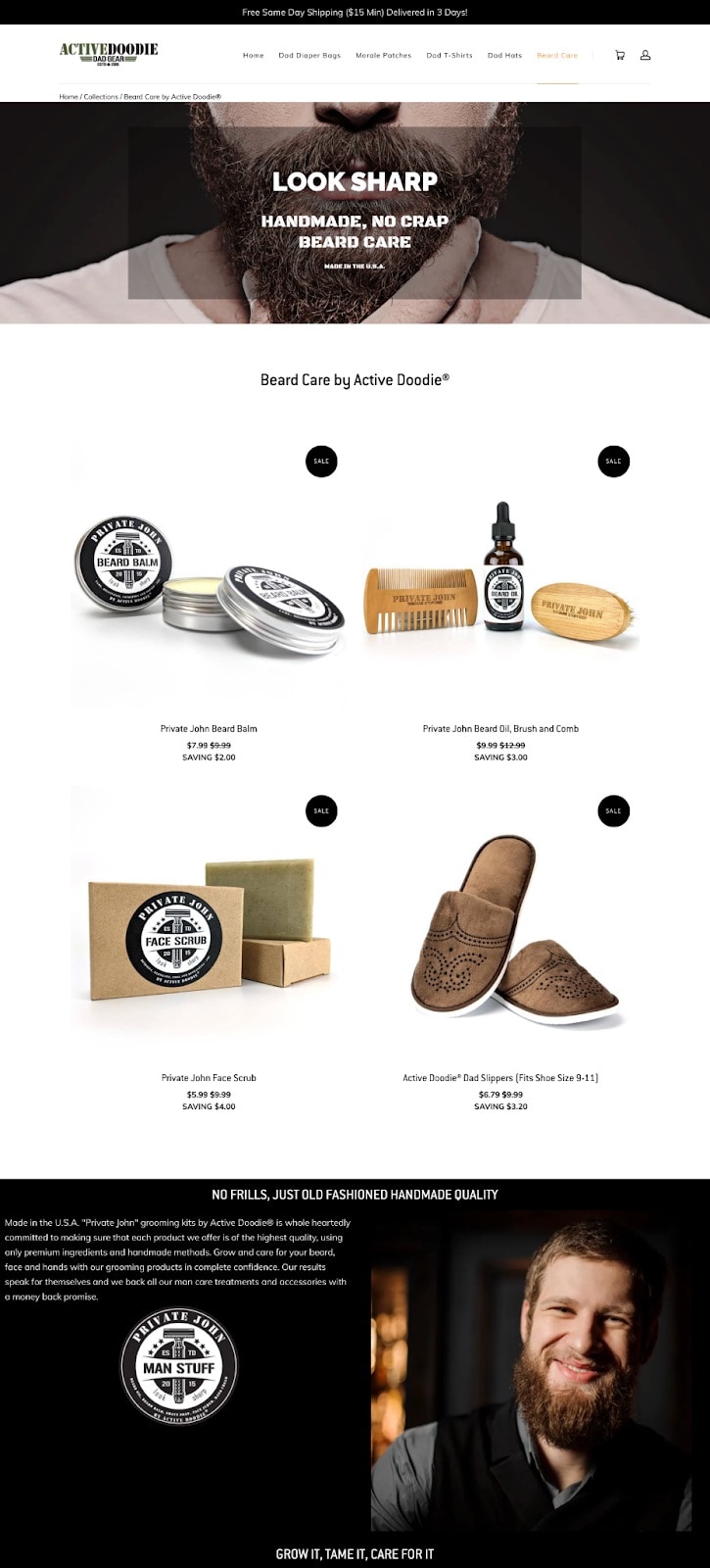
#cta-visual-pb#<cta-title>Want to create a product collection page like this one?<cta-title>Drag and drop together Shopify pages with stunning images using Shogun Page Builder. Start your free trial
#3) Test out benefit-driven copy
When a potential customer arrives on your landing page, you want to be immediately clear about what’s in it for them.
Make sure that your description copy is clear and conveys the main benefit of your product. How will it make the potential customer’s life better?
The sales copy on Goodboy’s store’s Shogun-built product page below clearly states what their customer’s pups will experience when they consume their product.

Note that there’s a difference between features and benefits:
- A feature is a function of a product, whereas a benefit is the value that the customer derives from a product
- Example: “Adjust the chair’s settings to suit your height and posture (feature), so you can sit comfortably and correctly at your desk” (benefit).
Features tell, benefits sell—meaning that people buy based on benefits. This is why you should emphasize benefits in the copy on your store’s pages.
#4) Revise your page to keep the copy short and simple
Difficult language doesn’t do well in ecommerce.
There is a strong correlation between reading ease, word count, and conversions.
If you want to optimize for readability, research indicates that you try to keep your copy under 300 words and at (or easier than) a middle school comprehension level.

This is the way Shogun customer Le Col designed their Shopify ‘Coming Soon’ page. In total, it contains approximately 70 words. It’s light on words, high on conversions.
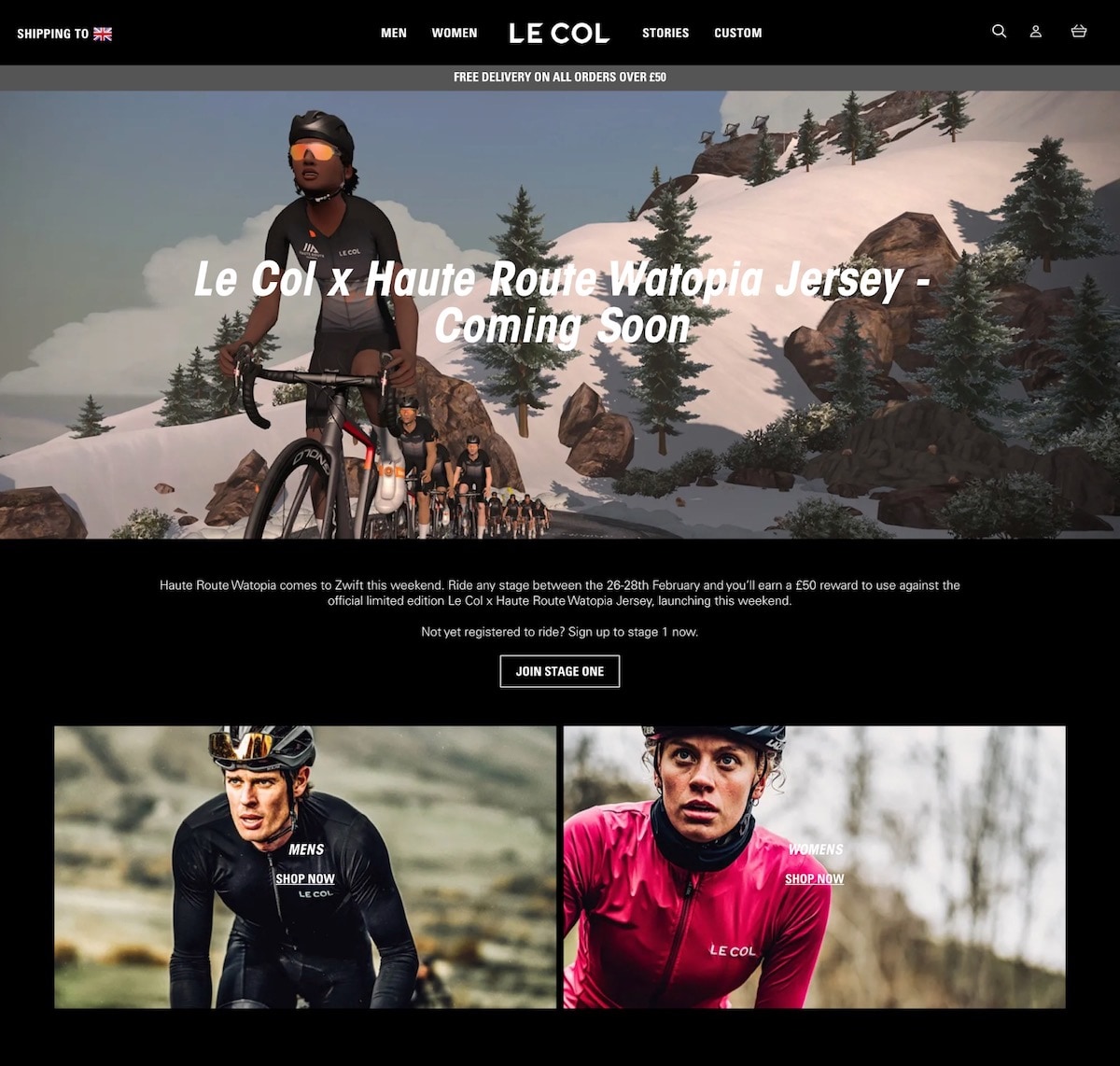
#5) Avoid negativity in your page’s copywriting
Did you know that ecommerce landing pages tend to be more emotional than those in other industries?
On average, they show higher levels of almost every sentiment.
This trend continued over the past year, with ecommerce businesses increasing their use of all types of emotional language. It seems that the increase in negative language was especially stark:
- Anger: +8.9%
- Fear: +6.5%
- Sadness: +8.1%
This is not surprising, given it has been such a turbulent year. However, when it comes to ecommerce pages, evoking emotions such as sadness or fear can negatively impact conversion rates.
Meanwhile, evoking emotions of joy and anticipation has been seen to correlate with an increase in conversion rates. Keep this in mind when writing your page’s sales copy.
Check out the TKEES Shogun-built landing page below. They go above and beyond in making their landing page copy pleasurable and friendly to read with positive words like “The Bright Side” and “May Cause Joy”.
The bright colors in the design and images complement the positive content, too.

#6) Add compelling social proof
Robert Cialdini—a professor of psychology and marketing—formulated six principles of persuasion, one of which is social proof:
When we are unsure of what to do, we look at what others do.
When a potential customer is unsure about buying your product, they’re likely to seek the opinions of others. In fact, 62% of shoppers consider reviews the most important factor when shopping.
That’s why it’s so important to provide as much social proof as you can in the form of:
- Product ratings
- Customer reviews
- Customer testimonials
- “As Seen On” media badges
- Other relevant information (e.g. your credentials, accomplishments, customer results, etc.).
Wild Earth is a great example of a Shopify store using various types of social proof on its Shogun-built landing pages.
Their limited-ingredient dog food landing page includes video testimonials, product ratings and customer reviews.
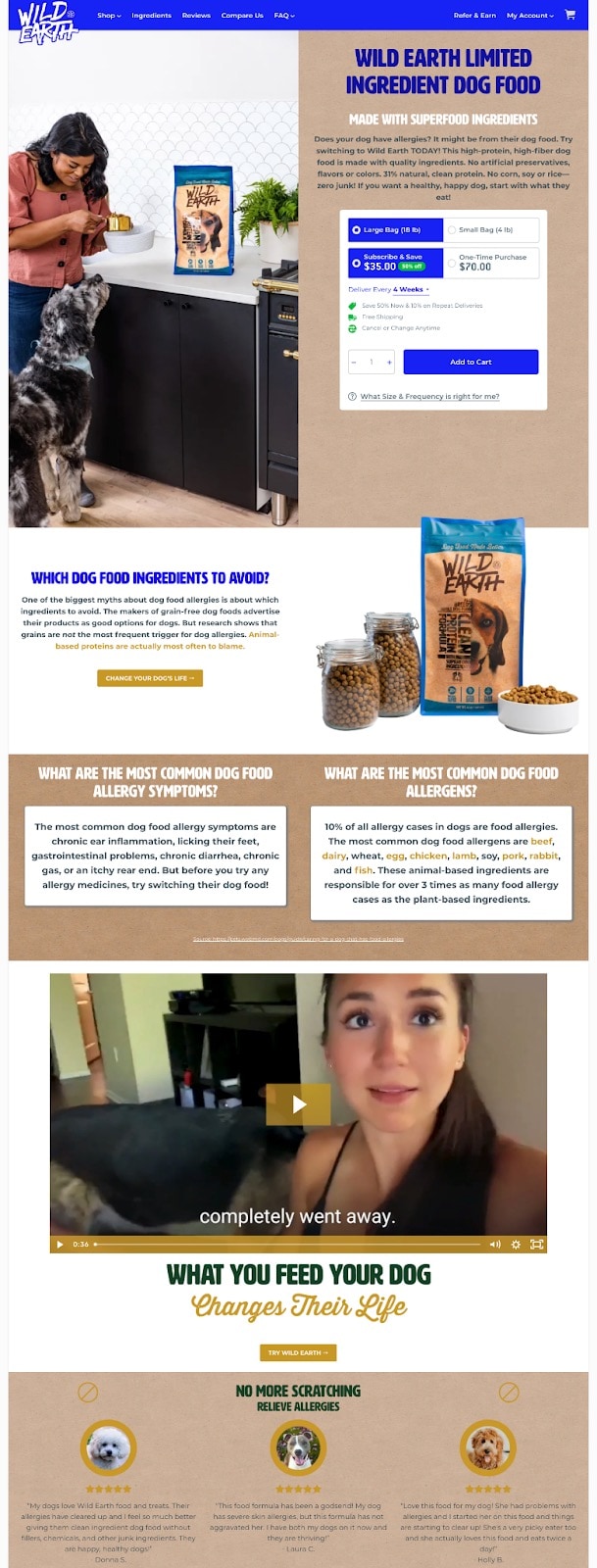
Also, when it comes to customer reviews and product ratings, resist the temptation to tamper with them. You don’t want a perfect score that looks fake. Instead, address your reviews and showcase that you’re doing your best publicly to make things right when there’s been a less-than-5-star experience.
#cta-visual-pb#<cta-title>Want to create social proof for your own Shopify landing pages?<cta-title>Check out the elements you can include with Shogun, like product reviews. See the Elements Library
#7) Test out the impact of offering free shipping
No one likes getting to the checkout just to be hit with huge shipping fees.
In fact, when online shoppers were surveyed to find out why they abandon their carts, 25% of them cited extra costs like shipping.
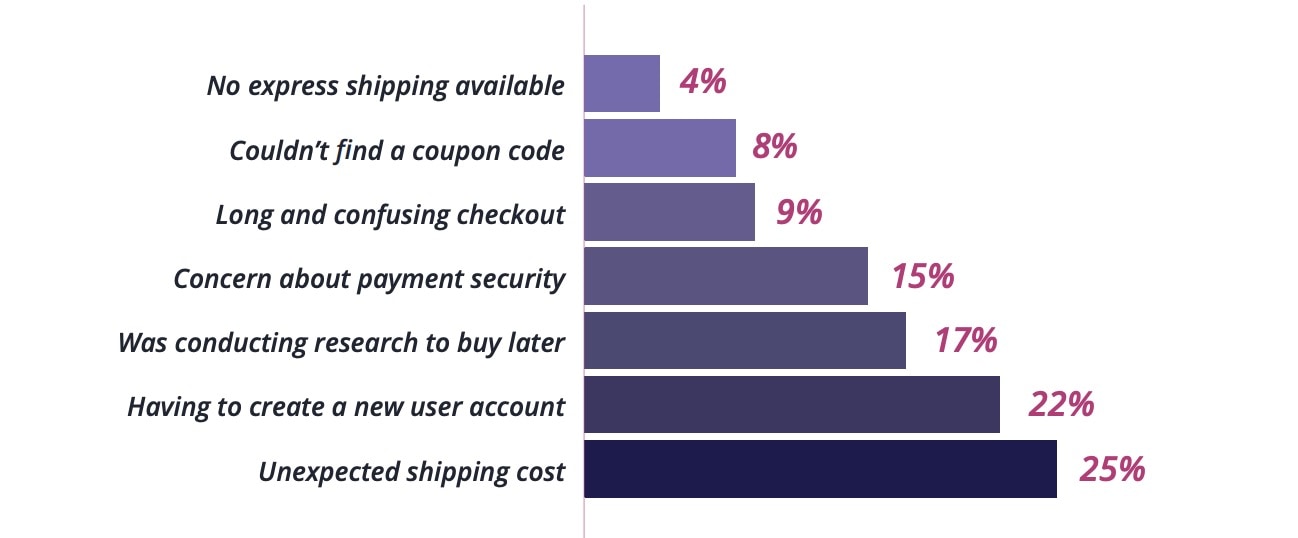
Moreover, according to the Walker Sands research, free shipping is the #1 driver of online purchases and has been for six years in a row.
It isn’t always possible to offer free shipping but you can experiment with this as a lever for driving conversions.
And if you can offer this, make sure to make it clear on your landing page!
#8) Try out implementing a money-back guarantee
When you shop at an online store, you can’t examine the product in person, so there’s more friction involved. What if it fails to meet expectations?
That’s why it’s not surprising that free returns or exchanges are the second biggest driver of online purchases.
Providing a no-questions-asked money-back guarantee if you want people to feel confident enough to purchase can make a big difference.
This can mean a 30, 60, or 90-day guarantee. Some ecommerce brands also offer a lifetime warranty. After all, 15% of online shoppers cite concern about payment security as their reason for abandoning carts.
Shogun customer Rumpl understands that its visitors can’t touch or feel the products they’re browsing, so they offer risk-free trials of their products for 100 nights and free returns. Check out how they indicate this on their storefront below:

To address their customer’s perceived risk and help them shop with confidence, they offer a risk-free trial for 100 nights and free returns.

#9) Display multiple call-to-action buttons that are value-focused
Calls to action are the step you are inviting your visitors to take next towards becoming a new customer or repeat buyer.
So make sure your landing page has multiple call-to-action buttons that grab users’ attention by ensuring they jump off the page:
- Make sure your CTA contrasts with your overall color scheme
- Provide breathing room around eye-catching CTA buttons
- Use words and phrases that clearly encourage action
You want the call-to-action button to be impossible to miss even if the potential customer is scrolling without reading the copy. It’s also an optimization strategy to have every button on the page be for the exact same, clear next step (i.e. “Shop the collection”, for example)
Nathan uses a wide variety of action-oriented CTAs to drive customers to product pages from their store’s collections page. They also use highly-visible CTAs in orange—the same color as the brand’s logo.

#10) Include videos to illustrate the value of your products
Using videos on your store’s pages to reveal how your products can help customers solve problems is a great way to increase your Shopify conversions. 96% of people have watched an explainer video to learn more about a product, and 84% said they’ve been convinced to buy this way.
Videos are also a great way to display testimonials—another important way to build brand authority and increase trust.
#cta-mini-pb#Want to add videos to your Shopify store pages? Explore all the elements you can add in Shogun’s Elements Library.
#11) Make your store landing pages load fast
Page speed matters more than you might think.
When Google conducted research on page speed, they found that it has a huge effect on the bounce rate.
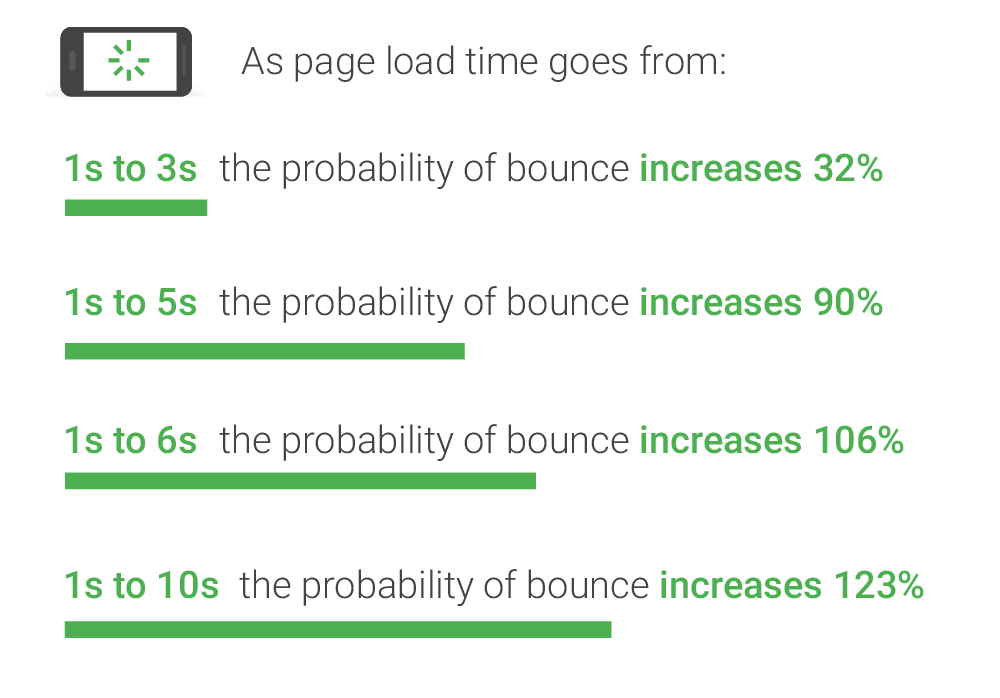
When pages take up to ten seconds to load, bounce rate probability increases by 123%! That’s a lot of missed conversions on the table.
Now get this: The average time it takes for a mobile landing page to fully load is 15 seconds. Can you imagine how much money online stores are losing because of this?
You can increase your page speed by:
- Minifying CSS, JavaScript, and HTML,
- Optimizing your images to be as small as possible without losing quality,
- Improving server response time.
Remember, when it comes to page speed, every second counts.
#12) Ensure your mobile view is optimized
Did you know that mobile traffic accounts for 54% of all global Internet traffic?
In some regions, such as Asia and Africa, the mobile traffic share is even larger (63% and 69%, respectively).
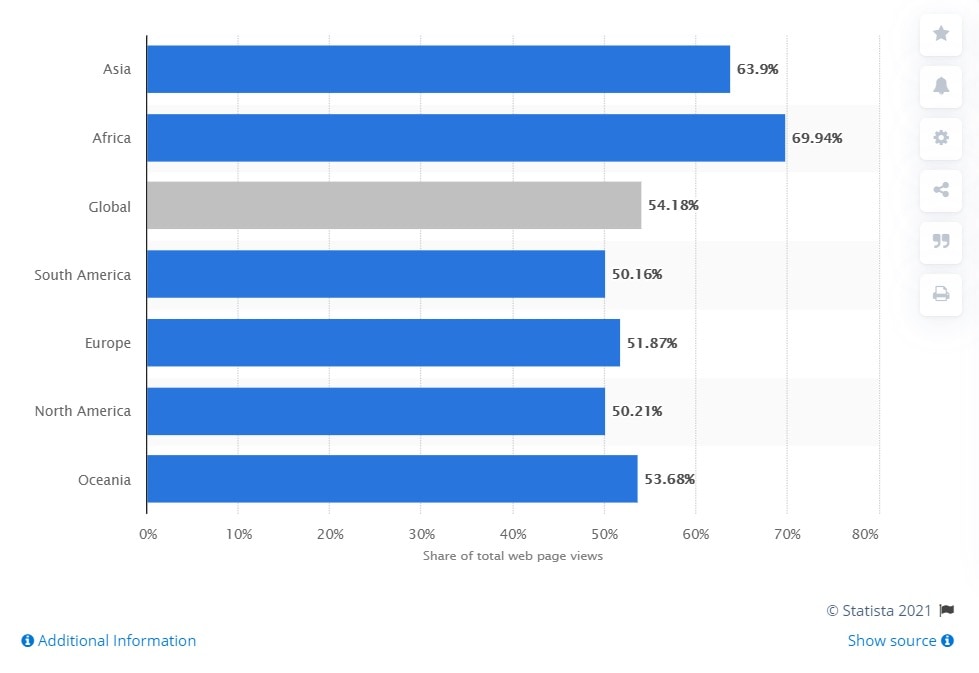
This means that if your landing page isn’t optimized for mobile, you are likely not catering to at least half of your visitors.
So before you publish a landing page, make sure to check how it looks on:
- A desktop or a laptop
- A smartphone
- A tablet
Shogun Page Builder makes that easy. You can preview your landing page to see how it looks on different devices.
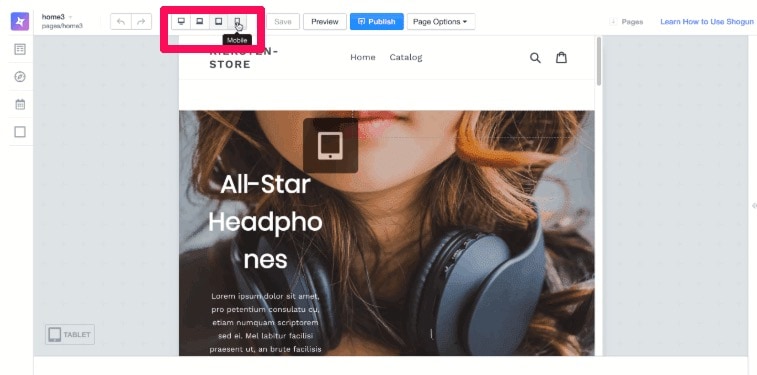
#13) A/B test your landing page
A/B testing is how you can identify what works and what doesn’t when it comes to converting more visitors to your store. To do this:
- You create two variants of the same page: variant A and variant B.
These pages should look exactly the same except for one element. That’s the element that you’re testing.
- You split the traffic into two and send 50% to variant A and 50% to variant B.
- You analyze the data after a determined test duration (for statistical significance) and keep the winning variant/learnings.
Note that it’s extremely important to only test one element at a time. Otherwise, you can’t know what caused the difference in the conversion rates.
Ideally, you should always be running A/B tests on your landing pages since tiny increases in the conversion rate add up over time.
Moreover, if you are always testing something, you are bound to stumble upon a big learning once in a while that has a significant effect on your conversion rate and can be applied to more store pages.
Go forth and optimize!
As we went through, the median ecommerce landing page conversion rate is 5.2%. But implementing some of the best practices in this article may be enough to have you converting much higher!
Overall, Shopify landing pages aren’t “set it and forget it”; they are living works-in-progress. You can continuously optimize them for the best results.
But enough with the theory. It’s time to put what you have learned into practice.
#cta-visual-pb#<cta-title>Try Shogun Page Builder for FREE<cta-title>Start building Shopify store pages your way and convert! Get Started

Michelle Deery
Michelle Deery is a writer and strategist for B2B SaaS companies. She writes content that helps brands convert visitors into paying customers.



